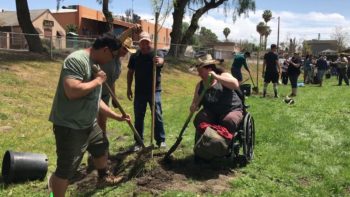The Board of Supervisors on Tuesday unanimously affirmed a plan to make sure the County’s vast and popular Parks and Recreation system can continue to thrive, no matter what’s going on with the larger economy or traditional funding sources.
“It’s unfortunate the State of California is cutting back on its parks,” said Board Chairman Bill Horn, who praised the plan that Parks officials presented Tuesday, noting that it will help the County avoid a budgetary crisis like the state’s that forced the closure of public parks, including Palomar Mountain State Park.
Parks and Recreation’s Cost Recovery, Resource Allocation and Revenue Enhancement Plan is a comprehensive business plan to help the County maintain and expand its 45,000-acre parks system while reducing its reliance on County General Fund dollars. Instead, the plan identifies alternative revenue sources such as private fundraising, grants, sponsorships, attracting more visitors and adjusting fees for certain programs.
“Historically, we’ve relied on the General Fund subsidy,” said Parks and Recreation Director Brian Albright. “The current economy and strain on the General Fund has stressed our system. We want to diversify our funding base over time and grow our range of services.”
Under the plan, costs could be decreased by jettisoning unpopular or duplicative programs, Parks staff explained Tuesday.
The plan is essentially a set of recommendations such as “Revamp the Parks Society (a nonprofit support group) to be an active fundraising body or foundation” and “Advance market position of identified services through increased marketing efforts.”
Some of the recommendations, including these two examples, can be implemented by Parks and Recreation over the next two years. Others would require the Board of Supervisors to change existing policy or authorize major park projects, such as installing zip lines or other new attractions.
At the Board’s direction in early 2010, Parks and Recreation began working with a consultant on the Cost Recovery plan. In 40 public meetings and a survey that was mailed to residents, the County asked residents to explain what they value in the County’s Parks and Recreation system.
Overwhelmingly, residents said they wanted the County to maintain what it has. That includes 34 local parks, seven regional parks, more than 300 miles of trails, fishing lakes, open space preserves, campgrounds, five community centers, sports parks, historic sites and more than 200 programs.
Residents said they especially value the parts of the system that provide positive activities for youth, promote healthy and active lifestyles and protect the environment.
With these priorities in mind, Parks and Recreation will use two models to approach any business changes.
The first model is a “Cost Recovery Pyramid,” which sets targets for how much of a program or facility cost should come from the County’s General Fund, and how much should come from other funding sources.
At the base of the pyramid are programs, services and parks with wide community benefit that are appropriate candidates for 100 percent support through County General Funds.
At the tip of the pyramid are programs, services and contracts that mostly benefit individuals and can’t justify a General Fund subsidy, such as private lessons, long-term leases and equipment rentals.
In between are programs that have mixed community and individual benefits. The County will target a mix of General Fund subsidies and other funding sources for those offerings.
The second model Parks and Recreation will embrace is called a Service Assessment Tool. This tool asks the department to look at the popularity, market position, revenue potential and uniqueness of its facilities and programs.
For example, County Recreation Program Manager Chief Christine Lafontant told the Board, the Summer Movies in the Park series around the region is popular, subsided through sponsorships and partnerships with other cities, and in a good position to grow. A program like this could be expanded and marketed widely.
On the other hand, an advanced computer class offered at a County community center benefits just a few people and doesn’t recover its cost. Plus similar affordable courses are offered at the region’s community colleges, Lafontant explained. Such a program might be dropped.
Vice-Chairman Ron Roberts praised the plan as evidence-based and reasonable.
“It’s hard to argue with these things,” he said.




